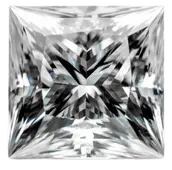
Gabrielle’s Ideals for Princess Diamonds
(Table: 65–74% (68–72; table lower than depth), Depth: 68–74% (69–73), Pavilion Depth: 54–62%, Pavilion Angle: 40–41° (40.2°–41.25°), Crown Angle: 34–35° (33.7°–35.8°), Crown Height: 10–14%, Girdle: 2.5–4.5%)
The princess cut diamond is the most popular square-shaped diamond, known for its sharp angles, intense brilliance, and modern appeal. As a modified brilliant cut, the princess cut delivers exceptional sparkle while offering a more contemporary look than round diamonds.
First developed in the 1960s, the princess cut was created as a more efficient alternative to the round brilliant. It retains up to 80% of the rough diamond (compared to ~50% for a round), making it a cost-effective choice with excellent light performance. Its chevron faceting pattern creates a unique sparkle, with distinct flashes of brilliance across the stone’s surface.
1. What Is a Princess Cut Diamond? #
The princess cut features a square shape with sharp, untrimmed corners and a multi-faceted pavilion, designed for maximum light return. Unlike step cuts (such as emerald and Asscher), the princess cut’s brilliant faceting pattern enhances fire and scintillation, making it one of the most radiant fancy-shaped diamonds.
The length-to-width ratio of a princess cut should ideally be 1.00–1.05 to maintain a square shape. Any higher than this, and the diamond may start to appear rectangular.
Why Choose a Princess Cut Diamond?
-
Bright & Sparkling:
As a brilliant cut, the princess cut delivers intense sparkle and light return.
-
Modern & Bold Look:
The square silhouette and sharp corners give it a sleek, contemporary feel.
-
More Affordable Than Rounds:
The princess cut uses more of the rough diamond, making it a cost-effective option with strong brilliance.
-
Hides Inclusions Well:
The brilliant facet structure disguises small inclusions better than step cuts.
Potential Downsides of a Princess Cut Diamond
-
Sharp Corners Are Fragile:
The pointed edges of a princess cut are prone to chipping, especially if the diamond is not set in a protective setting.
-
Less Fire Than a Round Brilliant:
While still incredibly brilliant, the princess cut does not disperse light as evenly as a round brilliant, meaning less rainbow fire in comparison.
-
Shows Color More Easily:
The cut can trap color near the corners, so lower color grades may appear slightly warmer.
-
Cut Quality Can Vary Greatly:
The princess cut has multiple faceting patterns, meaning two diamonds with similar specs can have very different light performance.
-
Not as Large Face-Up as Elongated Shapes:
A princess cut may appear smaller than an oval or radiant of the same carat weight due to its deep proportions.
#
#
2. The 4Cs for a Princess Lab Diamond #
While the 4Cs—Cut, Color, Clarity, and Carat—are fundamental for any diamond, the cut is paramount for princess diamonds, as it directly influences their light performance.
Cut – The Heart of Princess Brilliance
Dialing in the perfect cut means focusing on these key proportions:
-
Table Percentage (IGI’s ideals: 65–74% | Gabrielle’s Ideals: 68–72%; table lower than depth):
The table is the largest facet on the top of the diamond. Keeping it within the ideal range ensures that light enters properly and disperses to enhance both fire and brilliance.
-
Depth Percentage (IGI’s ideals: 68–74% | Gabrielle’s Ideals: 69–73%):
Depth controls the overall “height” of the stone relative to its width. An ideal depth prevents light from escaping or becoming trapped, maximizing sparkle.
-
Pavilion Depth (IGI’s ideals: 54–62% | Gabrielle’s Ideals: 55-60%):
The pavilion is where internal reflections take place. Proper pavilion depth is key to bouncing light back through the crown, ensuring a vibrant display.
-
Pavilion Angle (IGI’s ideals: 40–41° | Gabrielle’s Ideals: 40.2°–41.25°):
This angle directs light through the diamond. Even minor variations can significantly influence how brilliance and scintillation are achieved.
-
Crown Angle (IGI’s ideals: 34–35° | Gabrielle’s Ideals: 33.7°–35.8°):
The crown angle affects the dispersion of light. Staying within the ideal range helps enhance the stone’s fire while maintaining its overall brightness.
-
Crown Height (10–14%) & Girdle (2.5–4.5%):
These parameters contribute to both the stone’s aesthetic appeal and its durability, ensuring that the diamond performs optimally while withstanding everyday wear.
Pro Tip: Think of the table and pavilion as partners in controlling fire and brilliance, while the depth and crown work in tandem to manage light dispersion. Even if one proportion is slightly off, the others can compensate to yield a beautifully balanced stone.
Color – Enhancing the Icy Sparkle
Princess diamonds are cut to showcase a crisp, bright appearance. Choosing the right color grade enhances their natural sparkle:
-
D-F (Colorless): Provides a pristine, icy-white look that maximizes brilliance.
-
G-H (Near Colorless): Balances value with that sought-after white radiance.
-
I-J: May introduce a touch of warmth—ideal if you’re considering a yellow or rose gold setting, which can complement and balance the tone.
Pro Tip: For settings in yellow or rose gold, an H–J color grade can work exceptionally well, as the metal helps mask any slight warmth.
Clarity – Focus on Structural Integrity
Lab diamonds, including princess cuts, often have fewer inclusions than natural diamonds. Look for eye-clean clarity to ensure that nothing detracts from the stone’s luminous performance:
-
VS1–VS2: The sweet spot—offering excellent clarity and value without visible inclusions.
-
SI1–SI2: Acceptable if inclusions remain invisible without magnification.
-
VVS1–VVS2: Nearly flawless, though these come at a higher premium.
-
F–IF: Flawless stones exist but are generally unnecessary for most buyers.
Pro Tip: Avoid inclusions directly on the corners, as they may compromise the diamond’s structural integrity.
Carat – More Size for Your Budget
Princess cuts are deeper than rounds, meaning a 1.50ct princess cut will appear slightly smaller than a 1.50ct round.
Pro Tip: If maximizing size is a priority, consider increasing carat weight slightly to achieve a larger face-up appearance.
3. Additional Considerations #
Symmetry & Polish
-
Symmetry: Excellent symmetry ensures the diamond reflects light evenly for an elegant, well-proportioned appearance.
-
Polish: Excellent or very good polish is the best choice to maximize the crispness and cleanliness of the facets.
Fluorescence
-
None or Faint fluorescence is best—strong fluorescence may create a hazy effect.
Certification
-
Always buy IGI- or GIA-certified diamonds to ensure accurate grading.
Setting Considerations
-
Protect the Corners!
The pointed edges of a princess cut are prone to chipping—choose a setting that covers the corners with prongs.
-
Metal Choice: White gold or platinum enhances the icy brightness of a princess diamond, while yellow or rose gold can lend warmth and contrast.
-
Setting Style: Prong settings are ideal for maximizing light exposure, ensuring that every facet of the princess diamond contributes to its stunning sparkle.
#
#
Final Thoughts #
A well-cut princess diamond is a stunning blend of modern brilliance and geometric elegance. With strong sparkle, sharp edges, and a contemporary aesthetic, the princess cut is perfect for those who want a unique yet high-performing diamond.
By following Gabrielle’s Ideals, you can confidently select a princess cut diamond that is well-proportioned, bright, and durable.
Happy diamond hunting—may your princess cut diamond sparkle with bold brilliance and precision!



